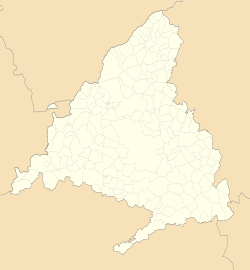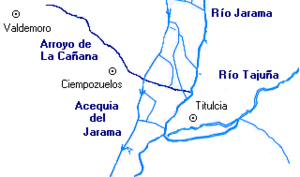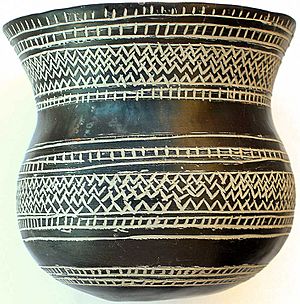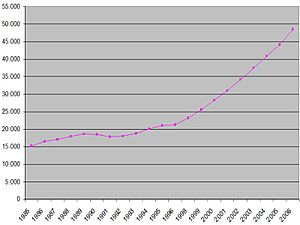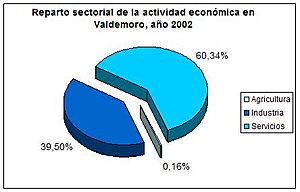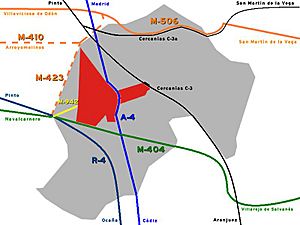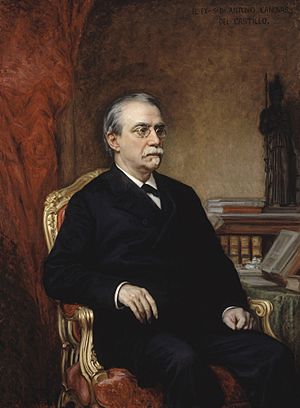Valdemoro facts for kids
Quick facts for kids
Valdemoro
|
||
|---|---|---|
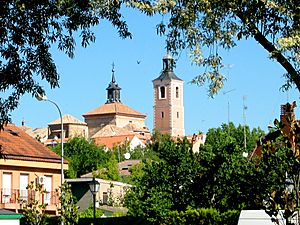 |
||
|
||
| Country | ||
| Autonomous community | ||
| Province | Madrid | |
| Comarca | La Sagra | |
| Judicial district | Valdemoro | |
| Founded | See text | |
| Area | ||
| • Total | 64.2 km2 (24.8 sq mi) | |
| Elevation | 615 m (2,018 ft) | |
| Highest elevation | 712 m (2,336 ft) | |
| Lowest elevation | 560 m (1,840 ft) | |
| Population
(2018)
|
||
| • Total | 74,745 | |
| • Density | 1,164.3/km2 (3,015.4/sq mi) | |
| Demonym(s) | Valdemoreños | |
| Time zone | UTC+1 (CET) | |
| • Summer (DST) | UTC+2 (CEST) | |
| Postal code |
28340–28343
|
|
| Dialing code | 91 | |
| Official language(s) | Spanish | |
Valdemoro is a town in the southern part of the Community of Madrid, Spain. It is about 27 kilometers (17 miles) from the capital city, Madrid. Valdemoro is officially part of the comarca (region) of La Sagra. However, it is also seen as part of the larger Madrid metropolitan area.
In the last 15 years, Valdemoro has grown a lot. Its population reached 74,745 people in 2018. Being close to Madrid has helped the town grow in both population and economy. Because of this growth, Valdemoro has built many new facilities. These include new ways to get around, schools, and places for health and fun.
The town's recent story is closely linked to the Guardia Civil. Valdemoro is home to a special academy for them. This academy, called Colegio de Guardias Jóvenes Duque de Ahumada, is only for children and orphans of current guardsmen.
Contents
Exploring Valdemoro's Geography
Valdemoro is located in the river basin of the Tagus River. It sits on the southern slopes of the Sistema Central mountain range. Most of the people in Valdemoro live in the western part of the town. This area is "along the road that connects Madrid to Aranjuez".
Land and Hills
The region is mostly flat. The only exceptions are the Espartinas hills in the south and the El Espartal farmlands in the east.
The highest point in Valdemoro is the Cerro de la Mira ("Hill of La Mira"). It is 712 meters (2,336 feet) high. The lowest point is the La Cañada stream, at 543 meters (1,781 feet). Valdemoro's average height is 615 meters (2,018 feet) above sea level. The land gently slopes towards the east.
Waterways
The La Cañada stream starts in Valdemoro. It then flows into the Jarama River. The Jarama River runs next to Valdemoro but does not enter its borders.
Valdemoro's Climate
Valdemoro has a Continental Mediterranean climate. Temperatures here average between 13°C and 17°C (55°F and 63°F) each year. Winters are usually mild. However, the sky can be cloudy and the ground frozen from November to April. Summers are hot and dry, with July averaging 26°C (79°F).
Most of the rain comes from the Atlantic Ocean. Mountain ranges around the Meseta Central and high-pressure systems from the Azores also affect the weather. Rainfall is not very common. This makes Valdemoro one of the driest places on the peninsula.
Plants and Animals
Valdemoro does not have a huge variety of plants or animals. However, 794 hectares (about 1,962 acres) of the town are part of the Parque Regional del Sureste. This is a protected natural park.
Valdemoro is one of the few places in Europe where the Russian silverberry tree (Elaeagnus angustifolia) grows naturally.
New buildings and towns have reduced the natural forest areas. The area is also home to 3 types of amphibians and 7 types of reptiles. There are 127 kinds of birds, with 67 species living and reproducing here. Of these, 21 species hibernate and 27 are nomadic.
Neighboring Towns
The city of Valdemoro shares borders with other towns. To the north are Pinto and San Martín de la Vega. To the east is Ciempozuelos. To the south are Seseña and Esquivias. To the west is Torrejón de Velasco.
Valdemoro has 12 neighborhoods. These include Río Nilo, Brezo, Campo Olivar, El Caracol, El Restón I, El Restón II, La Estación, La Villa, Las Vírgenes, Viva Verde, Las Comunidades, and UDE Norte-Oeste.
What's in a Name?
Legend says that the name Valdemoro comes from a saying. The local people resisted the Moorish invaders. This led to the saying En balde, Moro, te cansas, meaning "You tire yourself in vain, Moor." This saying supposedly became the name Valdemoro. However, it's more likely the name comes from Valle de Moro, meaning "Valley of the Moor(s)". This name was given after the Reconquista, when Christian kingdoms took back Spain.
Valdemoro's History
Early Times
Tools from the Copper Age have been found here. These include arrowheads, knives, and pieces of flint and quartzite. During the Bronze Age, people set up temporary camps in good locations. The first signs of people living here all the time date back to the Iron Age. These were found in the El Espartal farmlands in the eastern part of Valdemoro.
The most important discovery is the "Ciempozuelo type" of Bell Beaker. These vases were found in the far southeast of Valdemoro, near Ciempozuelos. They date back to around 1900 BCE. They are made of gray or black clay and have geometric patterns. Remains of a Roman villa from the Late Roman period have also been found. This villa was used until the Visigoth invasion.
The El Espartal farmlands are now a protected "Area of cultural heritage/interest" because of these finds.
How Valdemoro Was Founded
Old water systems found here show that Valdemoro was once a Moorish settlement. But people lived here even before the Moors arrived. These local people fought hard against the invasion.
After the Reconquista, two bishops argued over who would control Valdemoro. These were the bishops of Segovia and Palencia. In 1190, King Alfonso VIII and Pope Clement III stepped in. Valdemoro then became part of Segovia. Soon, Valdemoro became a very important town in the Sistema Central mountains. It was even more important than towns like Chinchón and Ciempozuelos.
Modern Age Developments
In the mid-1300s, Valdemoro became part of the lands owned by Hernán Pérez de Portocarrero. By the end of that century, it was controlled by the Archbishop of Toledo. Later, King Henry III of Castile gave Valdemoro the special title of Villa. This helped the town grow socially and economically.
In 1577, King Philip II took direct control of Valdemoro. Then, Melchor de Herrera took over. During his time, a religious community called Convento del Carmen was started. In 1602, Herrera's family sold the town to Francisco Goméz de Sandoval y Rojas, Duke of Lerma. He was a close friend of King Philip III. Under the Duke, Valdemoro saw much social growth. The Feria Barroca (Baroque Fair) was founded. In 1605, the Fuente de la Villa ("Village Fountain") was built. This is one of the town's most famous landmarks. In 1616, the Convento de Santa Clara was opened. Important artworks in the Church of Nuestra Señora de la Asunción were created in the late 1600s.

In the 1700s, Valdemoro improved thanks to José Aguado Correa. He helped the town recover from a tough period. The arrival of the House of Bourbon in Spain brought new industries. Aguado Correa started a textile factory in Valdemoro. By the late 1700s, Pedro López de Lerena, a Minister, opened public schools in 1792. He also paid for new art in the Church of Nuestra Señora de la Asunción. Famous artists like Francisco de Goya worked on it. López de Lerena tried to restart the factory, but it didn't work.
Even though the town's economy was mostly farming in the 1800s, gypsum mining slowly began. Valdemoro wines also became known in La Sagra. These early attempts at industry were stopped by the Peninsular War. The French army took over Valdemoro. This led to many losses for the town.
In 1822, Valdemoro officially became part of the province of Madrid. In 1851, a train line connecting Madrid to Aranjuez started stopping in Valdemoro. Soon after, in 1855, the Colegio de Guardias Jóvenes "Duque de Ahumada" was built. It was on the site of the old textile factory. The school moved out of town in 1972. Its old grounds are now the Parque Duque de Ahumada.
From the 1900s to Today
Valdemoro faced difficult times in the 1900s, especially during the Spanish Civil War. The economy only became stable again in the 1950s.
When democracy returned in 1975, Valdemoro began a new era. The town saw a lot of growth in buildings and industries. New industrial areas and neighborhoods like El Restón were built. This helped Valdemoro change from a farming town to a commuter town. This growth is still happening today, and the population is expected to keep increasing.
Valdemoro's Population
The first records of Valdemoro's population are from 1530. At that time, 2,216 people lived there. For the next few centuries, the population stayed between 2,000 and 4,000. It changed depending on living conditions.
In the 1970s, Valdemoro's population started to grow quickly. This was because of new industries and its closeness to Madrid. The biggest population jump happened after 2000. In 2001, Valdemoro had 30,986 people. By 2007, it had grown to 53,188. This was a 9% growth, one of the highest in the Community of Madrid. Between 2006 and 2007, Valdemoro was among the top five towns in Spain for population growth.
In 2006, there were 24,351 men and 24,166 women. About 20.51% of the people were younger than 15. Only 6.4% were older than 65. This is much lower than the 14.45% average for the rest of the Community of Madrid. The birth rate was 18.95%, and the death rate was 3.63%.
More people have moved to Valdemoro from other countries recently. In 1998, about 20.61 out of every 1000 people were immigrants. By 2006, this number grew to 110.87. Most immigrants come from Latin America and non-EU European countries.
Valdemoro is the 17th most populated city in the Comunidad de Madrid. It is the 131st most populated city in Spain.
Valdemoro's Economy
Until the 1960s, Valdemoro's economy was mainly based on farming. The land was split into 19 farming areas. Its industry was mostly gypsum quarries. These quarries were struggling because they were not modern.
Valdemoro saw a big increase in industry in the 1980s. This led to a fast growth in population. By 2002, the economy was divided like this:
- Agriculture: 0.16%
- Industry: 39.50%
- Services: 60.34%
Farming and Livestock
Because of its dry climate, Valdemoro's main crop is cereals. The main livestock raised here is poultry (like chickens). Like other developed areas in the Community of Madrid, this sector is becoming less important and smaller.
Industry
Valdemoro's industry is very important because it is close to Madrid. Many large Spanish and international companies have their main logistics centers here. These include the wholesaler El Corte Inglés, the car parts supplier Lear, and the oil company Total S.A..
Services
The service industry, which includes shops and businesses, is the most developed part of the economy. On average, 14.7% of the people work in these jobs. Valdemoro has two main shopping areas. One is Calle Estrella de Elola in the old part of town. The other is Centro Comercial El Restón, located in a newer neighborhood. There have been talks about new malls being built by companies like El Corte Inglés or Carrefour, but this has not been confirmed.
Getting Around Valdemoro
Roads
Valdemoro is connected by several important roads:
- National Autovías
- Toll Autopistas
- R-4: This toll road goes from the M-50 ring road to Ocaña.
- First-level Autonomous Roads
- M-506: Connects towns like Villaviciosa de Odón and San Martín de la Vega.
- M-410: Connects Arroyomolinos and Parla to Valdemoro (still being built).
- M-423: This is the Valdemoro West Bypass.
- Second-level Autonomous Roads
- M-404: Connects Navalcarnero to Villarejo de Salvanés.
- Third-level Autonomous Roads
- M-942: Connects M-404 to Valdemoro.
Train System
Valdemoro has a train station. It is on the Cercanías Madrid C-3 Line, which runs from Atocha to Aranjuez.
There have been talks about building a second station in the western part of town. No official plans have been made yet. However, land has been set aside for a new railway line and station. In 2006, the government announced a new stop on the C-3 Line between Valdemoro and Ciempozuelos. There are also plans for a high-speed train, part of the Alta Velocidad Española Madrid-Levante line, to pass through southern Valdemoro.
Buses
|
Buses within Valdemoro
|
Buses to Other Cities
|
Valdemoro has the second-highest number of bus routes in the Community of Madrid. It has 7 lines and 572 routes. Only Alcalá de Henares has more daily bus service.
Light Rail
The government has been looking into building a light rail system. This proposed line would connect Valdemoro's Cercanías train station to the El Restón and UDE Norte-Oeste neighborhoods and the Hospital. This project is part of a plan to expand the Madrid Metro network. The project was approved in July 2007.
Culture and Fun in Valdemoro
The main cultural spot in Valdemoro is the Centro Cultural Juan Prado. This center has an exhibition hall, a library, and the Teatro Municipal Juan Prado. It also houses the Department of Culture, Tourism, and Cultural Heritage offices. More fun activities are available at the Centro Lúdico ("Recreational Center") in the El Restón neighborhood.
Besides the library at the Cultural Center, Valdemoro has two other libraries. They are in the Viva Verde and El Restón neighborhoods. A new Biblioteca Central (Central Library) was built in 2007.
Valdemoro has 4 hotels and 6 hostels, with a total of 546 rooms. The town's closeness to the Parque Warner Madrid theme park and the capital city helps its hotel business grow.
Holidays and Celebrations
- Fiesta de Carnaval (February): A fun celebration with costumes and parades.
- San Marcos (25 April): This is an annual holiday celebrated in the Parque Bolitas del Airón. Long ago, it was a religious holiday to ask for good harvests. Now, it's a day for sports, entertainment, and cultural events.
- Santísimo Cristo de la Salud (Early May): These are the first main celebrations of the town. They started around 1650. People asked for permission to celebrate their patron saint. The celebrations include concerts, cultural events, and bullfights.
- Nuestra Señora del Rosario (8 September): These are the second main celebrations of the town, dating back about five centuries. Like the Cristo de la Salud fiestas, they include bullfights, cultural events, and various types of entertainment.
- Virgen del Pilar (12 October): A newer holiday for the Virgen del Pilar. A church in the El Restón neighborhood is dedicated to her.
- Feria Barroca (Early October): This is an annual artisan market from the 1600s. It was brought back in 2004.
Parks and Gardens
- Parque Bolitas del Airón: This 440,000 square meter (about 108 acres) green area is the "heart" of Valdemoro. It is the town's most famous park. It has the largest group of Russian silverberry trees in the Community of Madrid.
- Parque Tierno Galván: Named after a former mayor of Madrid, this is Valdemoro's second-largest park. It is 120,000 square meters (about 30 acres). It has a lake, small streams, a track, and playgrounds.
- Parque de España: This 45,000 square meter (about 11 acres) park is in the El Restón neighborhood. It has two lakes, a bike track, and playgrounds.
- Parque de la Alberiza: Built on a small hill at two different levels, this 11,000 square meter (about 2.7 acres) park has a central fountain. It is surrounded by rosebushes.
- Parque del Duque de Ahumada: Located in the historic area, on the site of the old Colegio de Guardias Jóvenes. The park has lawns, rosebushes, and flowers. It also has two fountains and Japanese wisteria plants.
- Jardín del Duque: Next to the Parque del Duque de Ahumada. This garden has a decorative fountain and a statue of a Guardia Civil guardsman.
- Parque Andalucía: This 6,700 square meter (about 1.6 acres) park is at the northern entrance to Valdemoro. It has a playground and a decorative fountain where people enjoy cooling off in summer.
Famous People from Valdemoro
- People born in Valdemoro
- Juan de Castro: An architect.
- Friar Alonso de la Cruz: A religious mystic.
- Juan Manuel Sotomayor: A Mexican judge.
- Friar Pedro Aguado: A religious writer.
- Friar Pedro de Palacios: A professor and bishop.
- Alejandro Aguado: A professor and historian.
- Diego de Pantoja: A missionary.
- Pedro López de Lerena: A Viceroy of Chile.
- Nicolasa Escamilla: A bullfighter.
- Miguel de los Santos: A journalist.
- Fernando García Morcillo: A composer.
- David Santisteban: A singer and composer.
- Jesús España: An athlete.
- Vicente López y López de Lerena: A doctor, priest, and writer.
- People who lived in Valdemoro
- Pedro Antonio de Alarcón: A novelist.
- Manuel Bretón de los Herreros: A writer and journalist.
- Antonio Cánovas del Castillo: A politician and historian.
- Antonio Cánovas del Castillo y Vallejo (also known as "Kaulak"): A photographer.
- Pedro Duque: An astronaut.
Sister Cities
Valdemoro has two sister cities:
See also
 In Spanish: Valdemoro para niños
In Spanish: Valdemoro para niños



